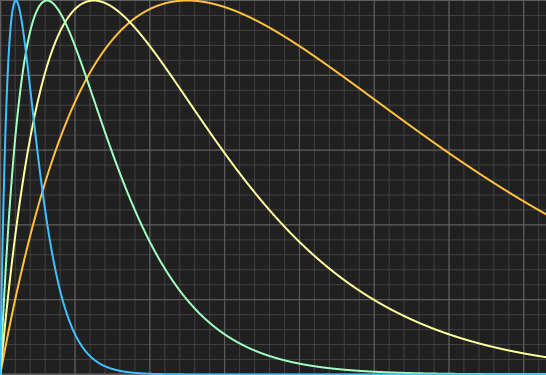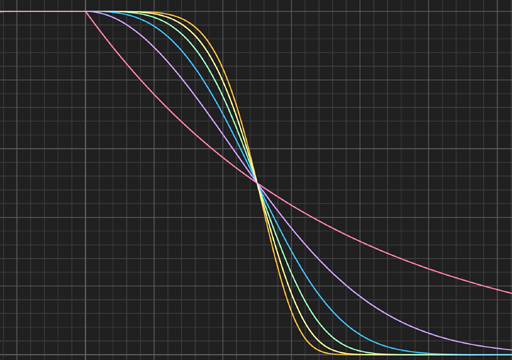useful little functions
来源:互联网 发布:亚瑟士系列 知乎 编辑:程序博客网 时间:2024/06/10 06:07
http://iquilezles.org/www/articles/functions/functions.htm
Intro
When writting shader or during any procedural creation process (texturing, modeling, shading, lighitng, animating...) you often find yourself modifying signals in different ways so they behave the way you want. It is common to use smoothstep() to threshold some values and still keep a smooth transition, or to pow() a signal to modify its contrast, to use a clamp() to clip, a fmod() to repeat, an over() to combine, a mix() to blend, a noise() to enrich, an exp() to attenuate, etc etc. These are nice functions cause they are available to you by default in most systems, as hardware instructions or as function calls, so we tend to use them. However there are some operations that are often used that don't exist in any language that you still use a lot. Never found yourself substracting to smoothstep()'s to isolate some range, ie, create a ring? Never found youself doing some smooth clipping to avoid dividing by huge numbers? Of course. This are some of these functions that I have collected over the years.
Almost Identity
Say you don't want to change a value unless it's too small and screws some of your computations up. Then, rather than doing a sharp conditional branch, you can blend your value with your threshold, and do it smoothly (say, with a cubic polynomial). Setm to be your threshold (anything above m stays unchanged), andn the value things will take when your value is zero. Then set
p(0) = n
p(m) = m
p(0) = 0
p(m) = 1
therefore, if p(x) is a cubic, then p(x) = x^3�(2n-m)/m3 + x^2*(2m-3n)/m2 + n
float almostIdentity( float x, float m, float n ){ if( x>m ) return x; const float a = 2.0f*n - m const float b = 2.0f*m - 3.0f*n; const float t = x/m; return (a*t + b)*t*t + n;} 
Impulse
Great for triggering behaviours or making envelopes for music or animation, and for anything that grows fast and then slowly decays. Usek to control the streching o the function. Btw, it's maximun, which is 1.0, happens at exactly x = 1/k.
float impulse( float k, float x ){ const float h = k*x; return h*expf(1.0f-h);} 
Cubic Pulse
Of course you found yourself doing smoothstep(c-w,c,x)-smoothstep(c,c+w,x) very often, probably cause you were trying to isolate some features. Then this cubicPulse() is your friend. Also, why not, you can use it as a cheap replacement for a gaussian.
float cubicPulse( float c, float w, float x ){ x = fabsf(x - c); if( x>w ) return 0.0f; x /= w; return 1.0f - x*x*(3.0f-2.0f*x);} 
Exponential Step
A natural attenuation is an exponential of a linearly decaying quantity: yellow curve, exp(-x). A gaussian, is an exponential of a quadratically decaying quantity: light green curve, exp(-x�). You can go on increasing powers, and get a sharper and sharper smoothstep(), until you get a step() in the limit.
float expStep( float x, float k, float n ){ return expf( -k*powf(x,n) );} 
Parabola
A nice choice to remap the 0..1 interval into 0..1, such that the corners are remaped to 0 and the center to 1. In other words, parabola(0) = parabola(1) = 0, and parabola(1/2) = 1.
float parabola( float x, float k ){ return powf( 4.0f*x*(1.0f-x), k );} 
Power curve
A nice choice to remap the 0..1 interval into 0..1, such that the corners are remaped to 0. Very useful to skew the shape one side or the other in order to make leaves, eyes, and many other interesting shapes
float pcurve( float x, float a, float b ){ float k = powf(a+b,a+b) / (pow(a,a)*pow(b,b)); return k * powf( x, a ) * powf( 1.0-x, b );}Note that k is chosen such that pcurve() reaches exactly 1 at its maximum for ilustration purposes, but in many applications the curve needs to be scaled anyways so the sholw computation ofk can be simply avoided. 
0 0
- useful little functions
- Useful functions in PHP
- 9 useful php functions
- Some Useful VBA Functions
- Useful Core Graphics functions
- some useful functions of c++
- Useful functions to provide secure PHP application
- 46 Useful Utility Functions For #Delphi XE8
- 9 Useful PHP Functions and Features You Need to Know
- Some useful functions from Oracle database 11g
- useful
- Useful
- useful
- useful
- 10+ Useful JavaScript Regular Expression Functions to improve your web applications efficiency
- 10+ Useful JavaScript Regular Expression Functions to improve your web applications efficiency
- functions
- functions
- 3Sum Closest - LeetCode
- 重生小说之别样人生
- URAL 1501 Sense of Beauty
- STL训练总结
- 02-线性结构1. 一元多项式求导 链表
- useful little functions
- 阴阳
- 如何高效学习
- 【BZOJ3629】【JLOI2014】聪明的燕姿 dfs 素数筛
- 五行
- 关于计算机中补码的个人理解
- Codeforces Round #297 (Div. 2) E Anya and Cubes
- android Application类的详细介绍
- 气血


